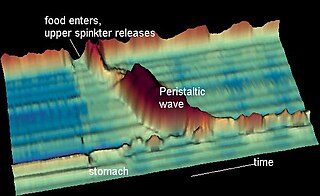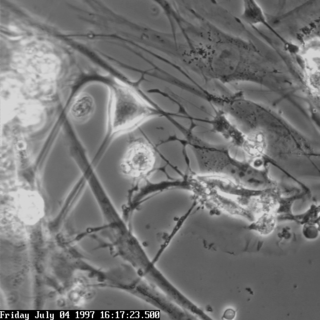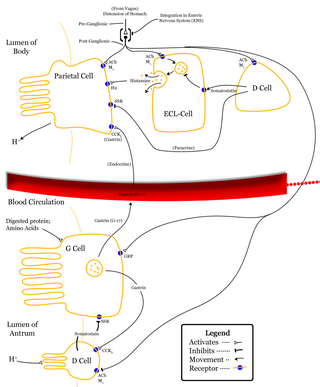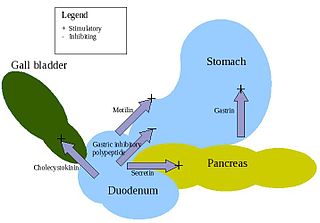
The stomach is a muscular, hollow organ in the gastrointestinal tract of humans and many other animals, including several invertebrates. The stomach has a dilated structure and functions as a vital organ in the digestive system. The stomach is involved in the gastric phase of digestion, following chewing. It performs a chemical breakdown by means of enzymes and hydrochloric acid.

The gastrointestinal tract is the tract or passageway of the digestive system that leads from the mouth to the anus. The GI tract contains all the major organs of the digestive system, in humans and other animals, including the esophagus, stomach, and intestines. Food taken in through the mouth is digested to extract nutrients and absorb energy, and the waste expelled at the anus as feces. Gastrointestinal is an adjective meaning of or pertaining to the stomach and intestines.

Peristalsis is a type of intestinal motility, characterized by radially symmetrical contraction and relaxation of muscles that propagate in a wave down a tube, in an anterograde direction. Peristalsis is progression of coordinated contraction of involuntary circular muscles, which is preceded by a simultaneous contraction of the longitudinal muscle and relaxation of the circular muscle in the lining of the gut.

The enteric nervous system (ENS) or intrinsic nervous system is one of the main divisions of the autonomic nervous system (ANS) and consists of a mesh-like system of neurons that governs the function of the gastrointestinal tract. It is capable of acting independently of the sympathetic and parasympathetic nervous systems, although it may be influenced by them. The ENS is nicknamed the "second brain". It is derived from neural crest cells.

Enterochromaffin (EC) cells are a type of enteroendocrine cell, and neuroendocrine cell. They reside alongside the epithelium lining the lumen of the digestive tract and play a crucial role in gastrointestinal regulation, particularly intestinal motility and secretion. They were discovered by Nikolai Kulchitsky.
An electrogastrogram (EGG) is a computer generated graphic produced by electrogastrography, which detects, analyzes and records the myoelectrical signal generated by the movement of the smooth muscle of the stomach, intestines and other smooth muscle containing organs. An electrogastroenterogram or electroviscerogram is a similar display of the recording of myoelectrical activity of gastrointestinal or other organs which are able to generate myoelectrical activity.

Interstitial cells of Cajal (ICC) are interstitial cells found in the gastrointestinal tract. There are different types of ICC with different functions. ICC and another type of interstitial cell, known as platelet-derived growth factor receptor alpha (PDGFRα) cells, are electrically coupled to smooth muscle cells via gap junctions, that work together as an SIP functional syncytium. Myenteric interstitial cells of Cajal (ICC-MY) serve as pacemaker cells that generate the bioelectrical events known as slow waves. Slow waves conduct to smooth muscle cells and cause phasic contractions.

Intestinal pseudo-obstruction (IPO) is a clinical syndrome caused by severe impairment in the ability of the intestines to push food through. It is characterized by the signs and symptoms of intestinal obstruction without any lesion in the intestinal lumen. Clinical features mimic those seen with mechanical intestinal obstructions and can include abdominal pain, nausea, abdominal distension, vomiting, dysphagia and constipation depending upon the part of the gastrointestinal tract involved.

Vagovagal reflex refers to gastrointestinal tract reflex circuits where afferent and efferent fibers of the vagus nerve coordinate responses to gut stimuli via the dorsal vagal complex in the brain. The vagovagal reflex controls contraction of the gastrointestinal muscle layers in response to distension of the tract by food. This reflex also allows for the accommodation of large amounts of food in the gastrointestinal tracts.
The enterogastric reflex is one of the three extrinsic reflexes of the gastrointestinal tract, the other two being the gastroileal reflex and the gastrocolic reflex. The enterogastric reflex is stimulated by duodenal distension. It can also be stimulated by a pH of 3-4 in the duodenum and by a pH of 1.5 in the stomach. Upon initiation of the reflex, the release of gastrin by G-cells in the antrum of the stomach is shut off. This in turn inhibits gastric motility and the secretion of gastric acid (HCl).

Enteroendocrine cells are specialized cells of the gastrointestinal tract and pancreas with endocrine function. They produce gastrointestinal hormones or peptides in response to various stimuli and release them into the bloodstream for systemic effect, diffuse them as local messengers, or transmit them to the enteric nervous system to activate nervous responses. Enteroendocrine cells of the intestine are the most numerous endocrine cells of the body. They constitute an enteric endocrine system as a subset of the endocrine system just as the enteric nervous system is a subset of the nervous system. In a sense they are known to act as chemoreceptors, initiating digestive actions and detecting harmful substances and initiating protective responses. Enteroendocrine cells are located in the stomach, in the intestine and in the pancreas. Microbiota plays key roles in the intestinal immune and metabolic responses in these enteroendocrine cells via their fermentation product, acetate.
Gastrointestinal physiology is the branch of human physiology that addresses the physical function of the gastrointestinal (GI) tract. The function of the GI tract is to process ingested food by mechanical and chemical means, extract nutrients and excrete waste products. The GI tract is composed of the alimentary canal, that runs from the mouth to the anus, as well as the associated glands, chemicals, hormones, and enzymes that assist in digestion. The major processes that occur in the GI tract are: motility, secretion, regulation, digestion and circulation. The proper function and coordination of these processes are vital for maintaining good health by providing for the effective digestion and uptake of nutrients.

Motilin receptor is a G protein-coupled receptor that binds motilin. It was first cloned in 1999 by Merck Laboratories. and scientists have since been searching for compounds to modify its behavior.
Gastroparesis, also called delayed gastric emptying, is a medical disorder consisting of weak muscular contractions (peristalsis) of the stomach, resulting in food and liquid remaining in the stomach for a prolonged period of time. Stomach contents thus exit more slowly into the duodenum of the digestive tract. This can result in irregular absorption of nutrients, inadequate nutrition, and poor glycemic control.

Homeobox protein CDX-1 is a protein in humans that is encoded by the CDX1 gene. CDX1 is expressed in the developing endoderm and its expression persists in the intestine throughout adulthood. CDX1 protein expression varies along the intestine, with high expression in intestinal crypts and diminishing expression along intestinal villi.
The basal or basic electrical rhythm (BER) or electrical control activity (ECA) is the spontaneous depolarization and repolarization of pacemaker cells known as interstitial cells of Cajal (ICCs) in the smooth muscle of the stomach, small intestine, and large intestine. This electrical rhythm is spread through gap junctions in the smooth muscle of the GI tract. These pacemaker cells, also called the ICCs, control the frequency of contractions in the gastrointestinal tract. The cells can be located in either the circular or longitudinal layer of the smooth muscle in the GI tract; circular for the small and large intestine, longitudinal for the stomach. The frequency of contraction differs at each location in the GI tract beginning with 3 per minute in the stomach, then 12 per minute in the duodenum, 9 per minute in the ileum, and a normally low one contraction per 30 minutes in the large intestines that increases 3 to 4 times a day due to a phenomenon called mass movement. The basal electrical rhythm controls the frequency of contraction but additional neuronal and hormonal controls regulate the strength of each contraction.

Anoctamin-1 (ANO1) also known as Transmembrane member 16A (TMEM16A) is a protein that, in humans, is encoded by the ANO1 gene. Anoctamin-1 is a voltage-gated calcium-activated anion channel, which acts as a chloride channel and a bicarbonate channel. additionally Anoctamin-1 is apical iodide channel. It is expressed in smooth muscle, epithelial cells, vomeronasal neurons, olfactory sustentacular cells, and is highly expressed in interstitial cells of Cajal (ICC) throughout the gastrointestinal tract.
A prokinetic agent is a type of drug which enhances gastrointestinal motility by increasing the frequency or strength of contractions, but without disrupting their rhythm. They are used to treat certain gastrointestinal symptoms, including abdominal discomfort, bloating, constipation, heart burn, nausea, and vomiting; and certain gastrointestinal disorders, including irritable bowel syndrome, gastritis, gastroparesis, and functional dyspepsia.

The gastrointestinal wall of the gastrointestinal tract is made up of four layers of specialised tissue. From the inner cavity of the gut outwards, these are:
- Mucosa
- Submucosa
- Muscular layer
- Serosa or adventitia

The human digestive system consists of the gastrointestinal tract plus the accessory organs of digestion. Digestion involves the breakdown of food into smaller and smaller components, until they can be absorbed and assimilated into the body. The process of digestion has three stages: the cephalic phase, the gastric phase, and the intestinal phase.














